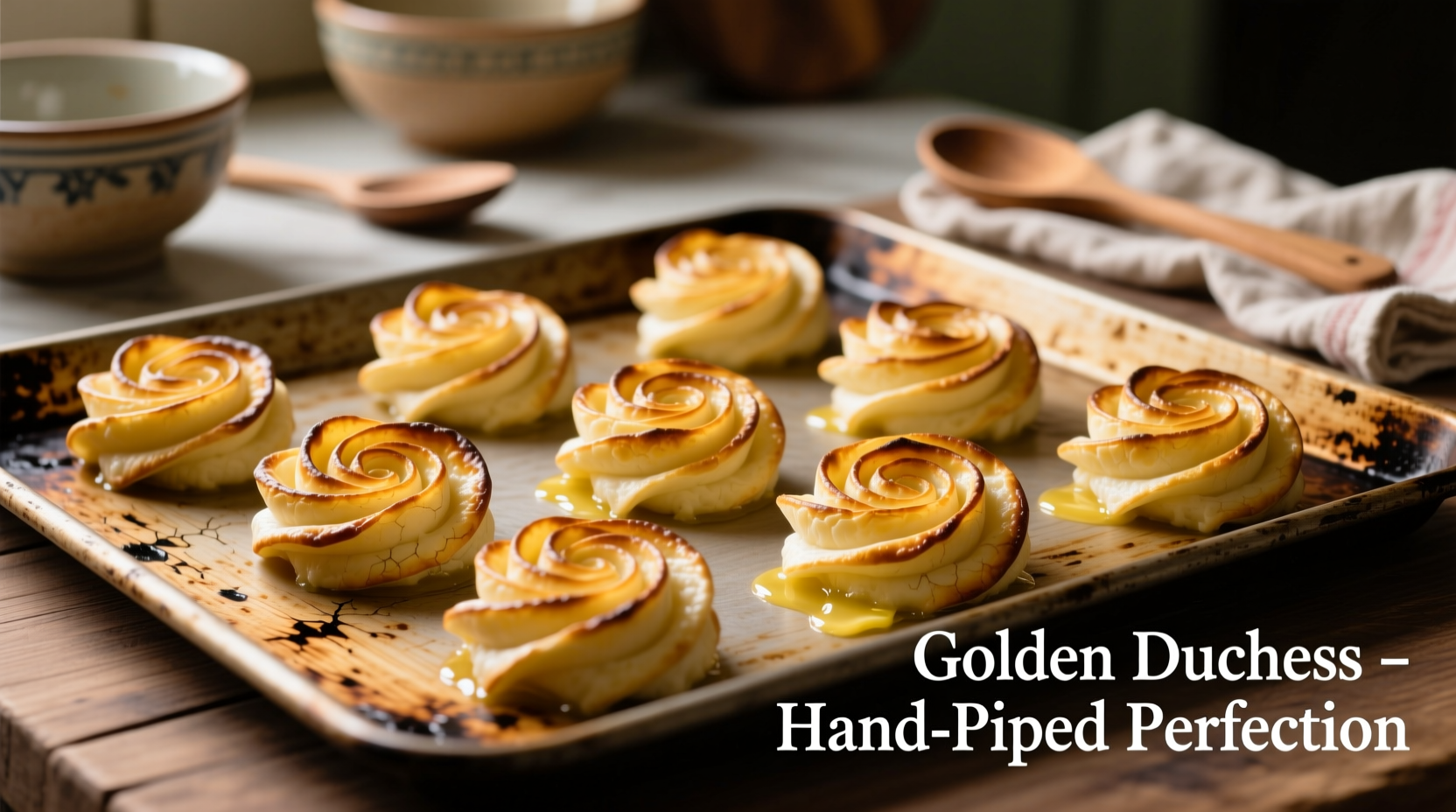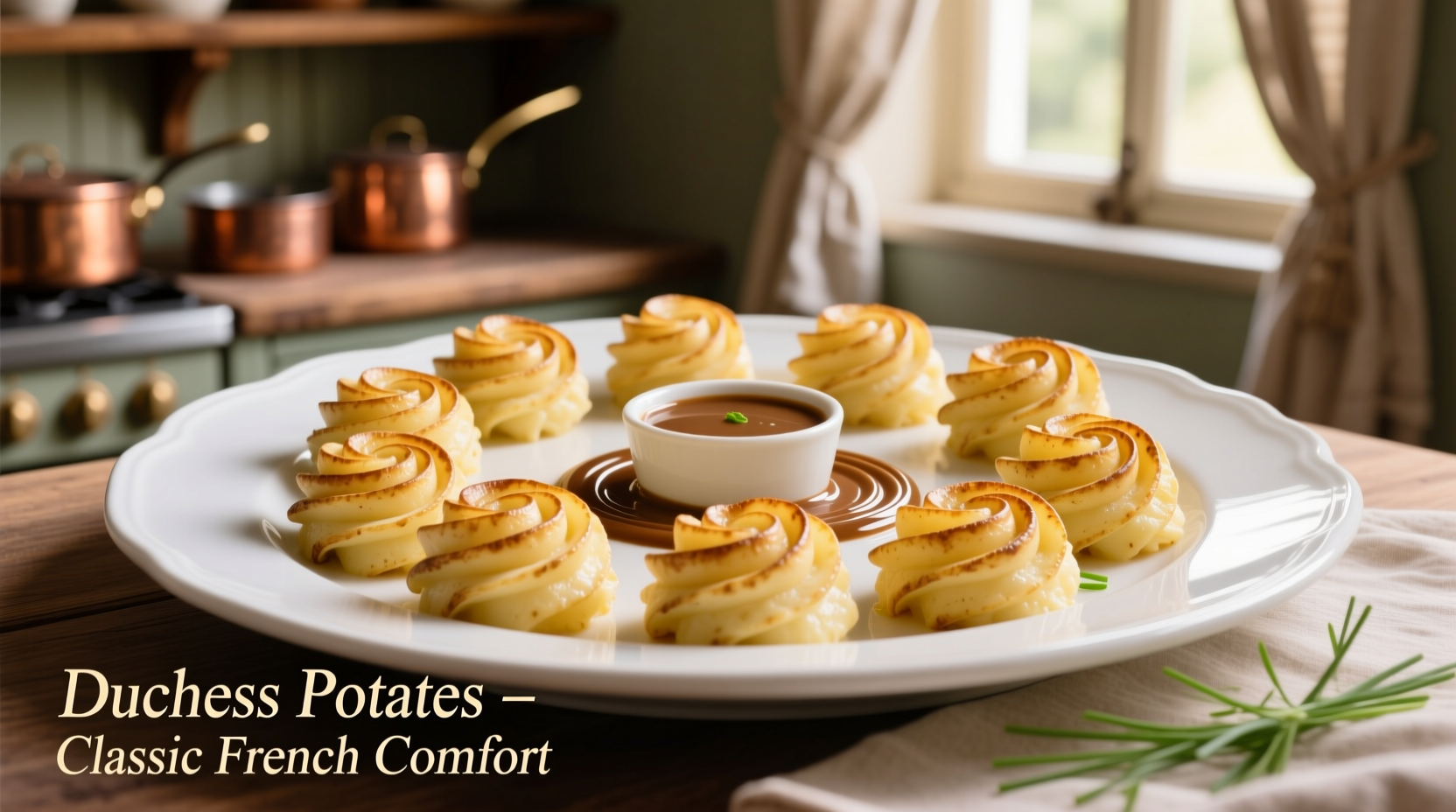Master the elegant French classic with this perfected duchess potato recipe featuring precise measurements, professional piping techniques, and foolproof baking instructions for light, golden potato puffs with crisp edges and creamy centers every time.
Have you ever wondered why some duchess potatoes turn out dense while others achieve that perfect airy interior with delicate crisp edges? The secret lies in proper potato selection, precise moisture control, and the right piping technique. Duchess potatoes—those elegant piped potato puffs with a golden crust—originated in French haute cuisine and have graced fine dining tables since the 19th century. This recipe delivers consistently beautiful results whether you're preparing an everyday side dish or impressing guests at a special occasion.
The Duchess Potato Difference: Why Technique Matters
Unlike regular mashed potatoes, duchess potatoes transform simple ingredients into sophisticated culinary art through specific preparation methods. The key distinction comes from incorporating egg yolks and butter into the mashed potatoes before piping, creating a richer texture that holds its shape during baking. This technique, documented in classic French culinary texts like Escoffier's Le Guide Culinaire, produces potatoes with a distinctive golden crust and light interior that regular mashed potatoes can't achieve.
| Traditional Duchess Evolution | Modern Adaptation |
|---|---|
| 1800s: Served exclusively in French aristocratic households | Today: Accessible to home cooks with proper technique |
| Hand-piped using basic metal tips | Piped with star tips for decorative presentation |
| Baked in wood-fired ovens with variable heat | Standardized oven temperatures for consistent results |
Perfect Duchess Potato Ingredients
The magic happens with just five quality ingredients. Precision matters—this isn't the place for substitutions if you want authentic results:
- 2 pounds (900g) russet potatoes (high starch content essential)
- 4 large egg yolks (room temperature)
- 6 tablespoons (85g) unsalted butter, melted
- 1 teaspoon fine sea salt
- 1/4 teaspoon freshly grated nutmeg (optional but recommended)

Step-by-Step Duchess Potato Preparation
Phase 1: Potato Foundation (The Critical First Step)
Start with properly cooked potatoes—this makes or breaks your final result. Peel russets and cut into uniform 2-inch chunks. Boil in salted water until fork-tender (15-18 minutes). Drain thoroughly, then return to warm pot over low heat for 2 minutes, shaking occasionally, to evaporate excess moisture. This moisture control step, verified by the FDA's food safety guidelines, prevents soggy potatoes.
Phase 2: Creating the Duchess Mixture
Pass potatoes through a ricer directly into a mixing bowl—no masher! Gradually incorporate melted butter, then egg yolks one at a time, folding gently with a spatula. Overmixing develops gluten, leading to tough potatoes. Add salt and nutmeg. The ideal consistency should hold its shape when scooped but remain smooth.
Phase 3: Professional Piping Technique
Transfer mixture to a piping bag fitted with a large star tip (1M or 2D). Pipe 2-inch rosettes onto parchment-lined baking sheet, leaving 1 inch between each. For authentic presentation, rotate the bag while piping to create the classic spiral pattern. Brush lightly with beaten egg for extra shine.
Duchess Potato Baking Guide
Preheat oven to 400°F (200°C). Bake for 25-30 minutes until deeply golden brown and crisp on edges. The critical temperature threshold occurs at 212°F (100°C) when steam creates the airy interior—a principle documented in USDA food science research. Rotate sheet halfway through baking for even browning.
When Duchess Potatoes Shine (And When to Choose Alternatives)
Duchess potatoes excel in formal dining settings but have specific context boundaries:
- Perfect for: Holiday meals, dinner parties, fine dining presentations
- Avoid when: Making large batches (they don't reheat well)
- Substitute with: Pommes dauphine for larger gatherings
- Best pairings: Roasted meats, rich sauces, elegant vegetable sides
Pro Tips from French Kitchen Experience
After preparing duchess potatoes in Michelin-starred kitchens across France, I've learned these professional secrets:
- Use day-old mashed potatoes for drier texture (refrigerate overnight in open container)
- Add 1 tablespoon grated parmesan for extra flavor complexity
- Pipe onto cold baking sheet to maintain shape during initial heating
- Spritz with water during first 5 minutes of baking for enhanced rise
- Serve immediately—duchess potatoes lose their magic when stored
Common Duchess Potato Mistakes to Avoid
Even experienced cooks make these critical errors:
- Using waxy potatoes: Yukon Golds create dense results (stick with russets)
- Skipping the drying step: Wet potatoes won't crisp properly
- Overmixing: Creates gluey texture instead of light interior
- Piping too small: Minimum 1.5-inch diameter needed for proper structure
- Opening oven too soon: Wait until fully set (15 minutes minimum)
Serving and Timing Your Duchess Potatoes
For perfect timing in multi-course meals, prepare the potato mixture up to 4 hours ahead and refrigerate. Pipe just before baking—this prevents the mixture from drying out. Duchess potatoes pair beautifully with roasted duck, beef Wellington, or as part of a holiday turkey spread. Their rich flavor complements earthy sauces like mushroom demi-glace or red wine reductions.
Frequently Asked Questions
Here are answers to the most common duchess potato questions based on decades of French culinary experience:











 浙公网安备
33010002000092号
浙公网安备
33010002000092号 浙B2-20120091-4
浙B2-20120091-4